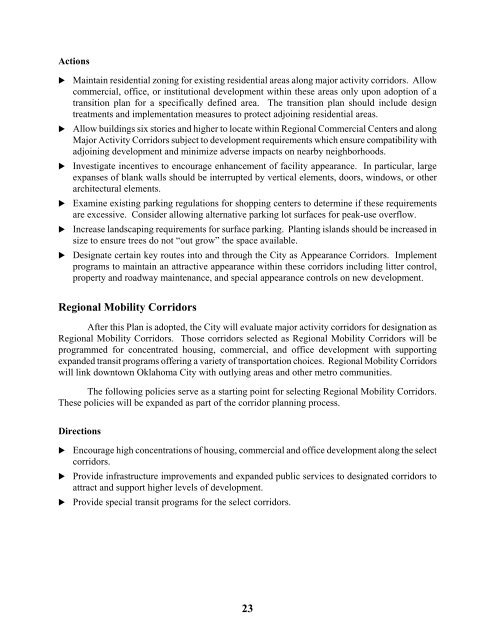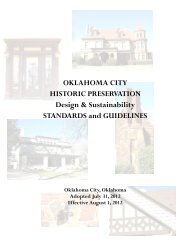OKC Plan, 2000-2020 - City of Oklahoma City
OKC Plan, 2000-2020 - City of Oklahoma City
OKC Plan, 2000-2020 - City of Oklahoma City
Create successful ePaper yourself
Turn your PDF publications into a flip-book with our unique Google optimized e-Paper software.
Actions<br />
Maintain residential zoning for existing residential areas along major activity corridors. Allow<br />
commercial, <strong>of</strong>fice, or institutional development within these areas only upon adoption <strong>of</strong> a<br />
transition plan for a specifically defined area. The transition plan should include design<br />
treatments and implementation measures to protect adjoining residential areas.<br />
Allow buildings six stories and higher to locate within Regional Commercial Centers and along<br />
Major Activity Corridors subject to development requirements which ensure compatibility with<br />
adjoining development and minimize adverse impacts on nearby neighborhoods.<br />
Investigate incentives to encourage enhancement <strong>of</strong> facility appearance. In particular, large<br />
expanses <strong>of</strong> blank walls should be interrupted by vertical elements, doors, windows, or other<br />
architectural elements.<br />
Examine existing parking regulations for shopping centers to determine if these requirements<br />
are excessive. Consider allowing alternative parking lot surfaces for peak-use overflow.<br />
Increase landscaping requirements for surface parking. <strong>Plan</strong>ting islands should be increased in<br />
size to ensure trees do not “out grow” the space available.<br />
Designate certain key routes into and through the <strong>City</strong> as Appearance Corridors. Implement<br />
programs to maintain an attractive appearance within these corridors including litter control,<br />
property and roadway maintenance, and special appearance controls on new development.<br />
Regional Mobility Corridors<br />
After this <strong>Plan</strong> is adopted, the <strong>City</strong> will evaluate major activity corridors for designation as<br />
Regional Mobility Corridors. Those corridors selected as Regional Mobility Corridors will be<br />
programmed for concentrated housing, commercial, and <strong>of</strong>fice development with supporting<br />
expanded transit programs <strong>of</strong>fering a variety <strong>of</strong> transportation choices. Regional Mobility Corridors<br />
will link downtown <strong>Oklahoma</strong> <strong>City</strong> with outlying areas and other metro communities.<br />
The following policies serve as a starting point for selecting Regional Mobility Corridors.<br />
These policies will be expanded as part <strong>of</strong> the corridor planning process.<br />
Directions<br />
Encourage high concentrations <strong>of</strong> housing, commercial and <strong>of</strong>fice development along the select<br />
corridors.<br />
Provide infrastructure improvements and expanded public services to designated corridors to<br />
attract and support higher levels <strong>of</strong> development.<br />
Provide special transit programs for the select corridors.<br />
23

















